Effective teamwork is critical in today’s collaborative and dynamic business environment. Among the key drivers of team performance are interpersonal skills and communication. These elements are fundamental to ensuring cohesive team functioning, conflict resolution, goal alignment, and enhanced productivity. This article explores the key components, roles, importance, and challenges of interpersonal skills and communication within teams, offering theoretical insights and practical examples relevant to MBA students.
Interpersonal Skills in a Team Context
Interpersonal skills refer to the abilities used to effectively interact, communicate, and collaborate with others. Within teams, these skills influence how well members connect, share ideas, manage conflicts, and build trust.
- Involve both verbal and non-verbal communication.
- Include empathy, active listening, and emotional intelligence.
- Foster mutual respect and collaboration among team members.
- Influence the quality of decision-making and team cohesion.
Interpersonal skills in teams are not limited to friendly interactions—they play a strategic role in influencing team dynamics, reducing miscommunications, and achieving shared objectives.
Types of Interpersonal Skills Crucial for Teams
Several types of interpersonal skills are essential for effective teamwork. Each contributes uniquely to the functionality and performance of a team.
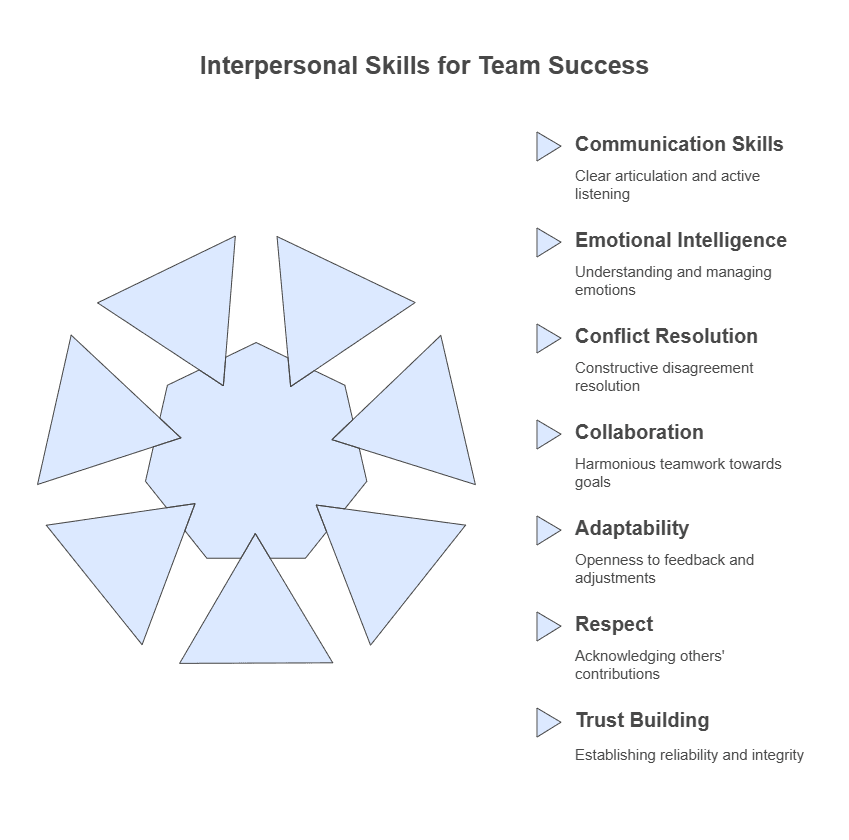
- Communication Skills: Clear articulation of thoughts and ideas, active listening.
- Emotional Intelligence: Understanding and managing one’s own emotions and empathizing with others.
- Conflict Resolution: Addressing and resolving disagreements constructively.
- Collaboration and Cooperation: Working together harmoniously towards common goals.
- Adaptability: Being open to feedback and adjusting behaviors accordingly.
- Respect and Courtesy: Acknowledging the contributions and perspectives of others.
- Trust Building: Establishing reliability and integrity within the group.
These skills collectively enhance understanding, minimize friction, and drive productivity within teams.
The Role of Communication in Team Success
Communication is the lifeblood of teamwork. It involves the exchange of information, ideas, and feedback through various channels and methods, both formal and informal.

- Encourages transparency and clarity of goals.
- Enables coordination of tasks and responsibilities.
- Facilitates feedback and continuous improvement.
- Enhances morale by ensuring everyone feels heard and valued.
Effective communication ensures that all team members are aligned and engaged, leading to more efficient project execution and greater innovation.
Key Components of Interpersonal Communication in Teams
To ensure effective interpersonal communication within teams, several components must be addressed.
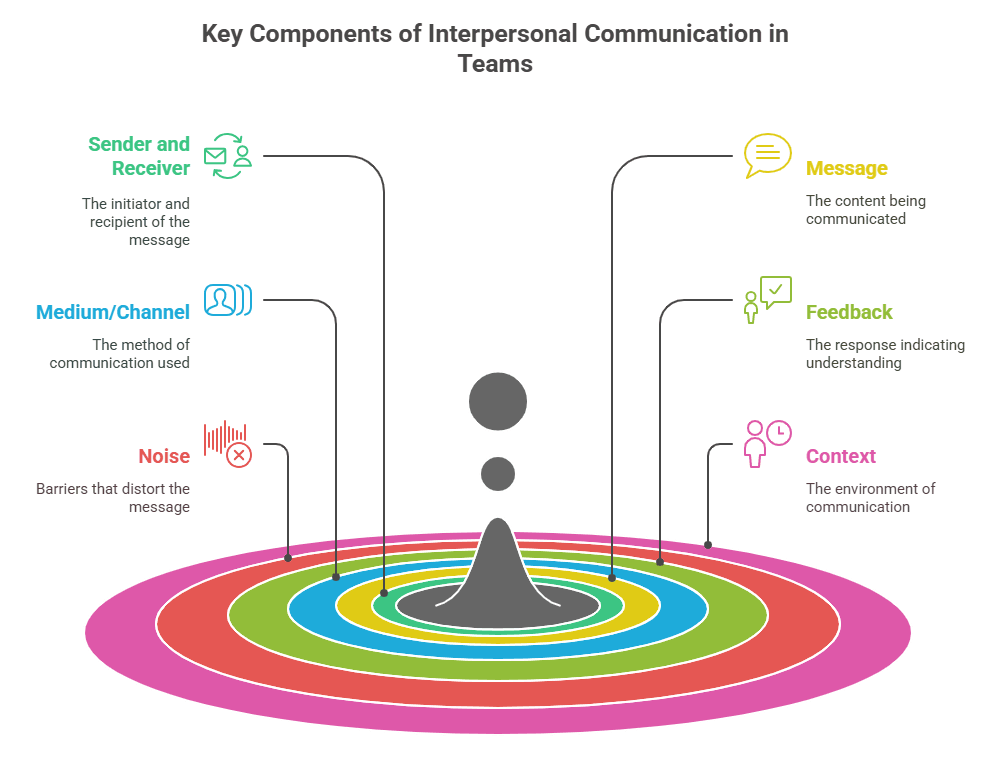
- Sender and Receiver: The initiator of the message and the recipient.
- Message: The content being communicated.
- Medium/Channel: The method of communication (e.g., face-to-face, email, chat).
- Feedback: The response that indicates the message was received and understood.
- Noise: Any barrier that distorts the message (e.g., language differences, distractions).
- Context: The environment or situation in which communication occurs.
Understanding these components helps team members navigate conversations more effectively, minimizing miscommunication and enhancing collaboration.
Importance of Interpersonal Skills and Communication Within Teams
The integration of strong interpersonal skills and effective communication is vital for team success in any organization.
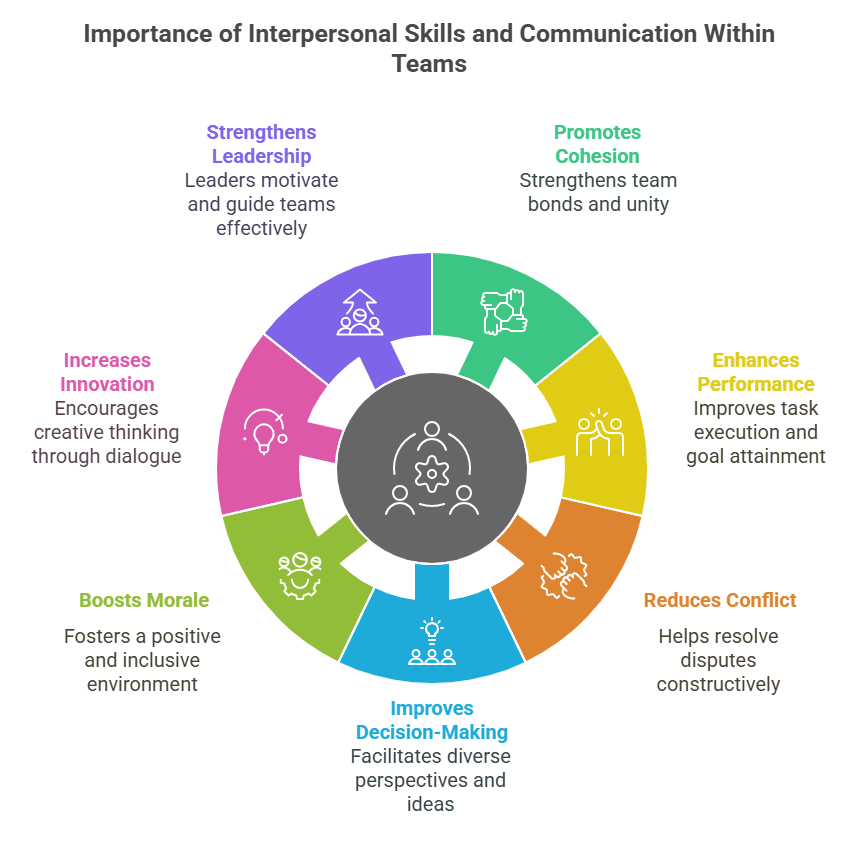
- Promotes Cohesion: Strengthens bonds and unity among team members.
- Enhances Performance: Encourages better task execution and goal attainment.
- Reduces Conflict: Helps preempt and resolve disputes constructively.
- Improves Decision-Making: Facilitates the flow of diverse perspectives and ideas.
- Boosts Morale: Fosters a positive, respectful, and inclusive work environment.
- Increases Innovation: Encourages creative thinking through open dialogue.
- Strengthens Leadership: Leaders with strong interpersonal skills are more effective at motivating and guiding teams.
A team that communicates well and values interpersonal interactions is more agile, adaptive, and resilient.
Challenges in Team Communication and Interpersonal Interactions
Despite their benefits, interpersonal skills and team communication often face hurdles that can impede team success.

- Cultural and Language Barriers: Differences can lead to misunderstandings.
- Lack of Trust: Hinders openness and honest feedback.
- Poor Listening Skills: Leads to misinterpretation and conflict.
- Personality Clashes: Conflicting styles can affect collaboration.
- Uneven Participation: Dominance by certain members can silence others.
- Remote Work Barriers: Digital communication lacks emotional cues and spontaneity.
- Ambiguity: Vague or inconsistent messages create confusion.
Recognizing these challenges is the first step in addressing and overcoming them to maintain effective team functioning.
Strategies to Improve Interpersonal Skills in Teams
Developing interpersonal skills is an ongoing process requiring awareness, feedback, and practice.
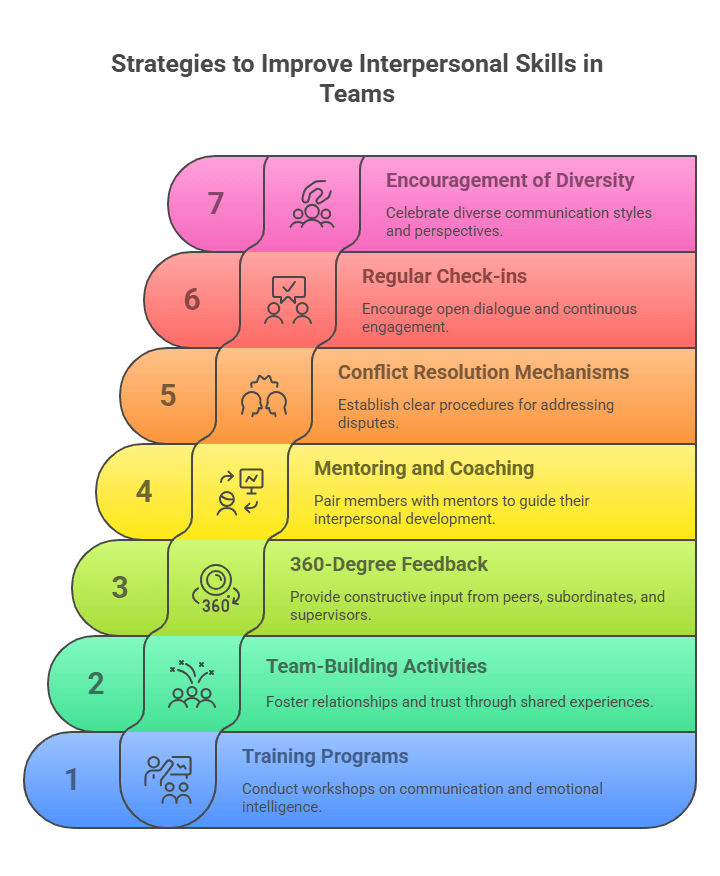
- Training Programs: Conduct workshops on communication and emotional intelligence.
- Team-Building Activities: Foster relationships and trust through shared experiences.
- 360-Degree Feedback: Provide constructive input from peers, subordinates, and supervisors.
- Mentoring and Coaching: Pair members with mentors to guide their interpersonal development.
- Conflict Resolution Mechanisms: Establish clear procedures for addressing disputes.
- Regular Check-ins: Encourage open dialogue and continuous engagement.
- Encouragement of Diversity: Celebrate diverse communication styles and perspectives.
Implementing these strategies helps create a culture where effective communication and interpersonal skills are nurtured.
The Impact of Technology on Team Communication
With increasing reliance on digital tools, technology significantly influences how team communication is conducted.
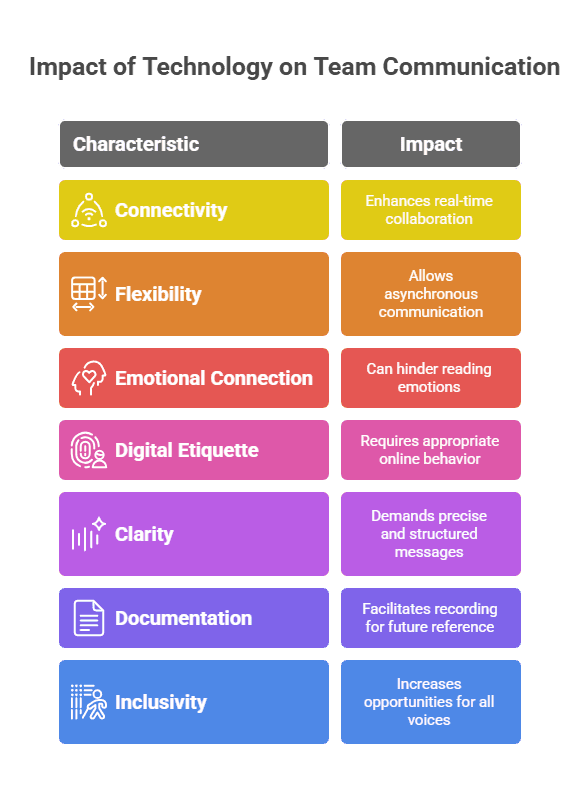
- Enhances Connectivity: Enables real-time collaboration across locations.
- Provides Flexibility: Allows asynchronous communication via emails, chats, etc.
- Can Hinder Emotional Connection: Limits the ability to read body language and emotions.
- Requires Digital Etiquette: Inappropriate tone or delayed responses can cause friction.
- Demands Clarity: Written messages need to be more precise and structured.
- Facilitates Documentation: Communications are easily recorded for future reference.
- Increases Inclusivity: Provides opportunities for all voices to be heard.
Technology can be both a facilitator and a barrier, depending on how it’s used within the team.
Role of Leadership in Fostering Interpersonal Communication
Leaders play a pivotal role in setting the tone for communication within teams. Their interpersonal competence often determines the team’s dynamics.
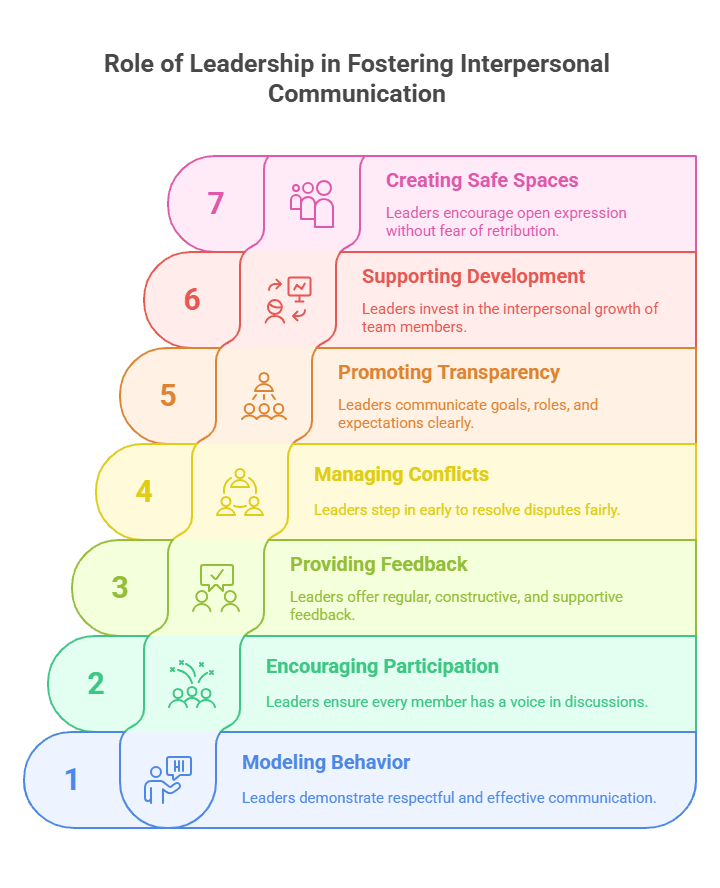
- Modeling Behavior: Demonstrate respectful and effective communication.
- Encouraging Participation: Give every member a voice in discussions.
- Providing Feedback: Offer regular, constructive, and supportive feedback.
- Managing Conflicts: Step in early to resolve disputes fairly.
- Promoting Transparency: Communicate goals, roles, and expectations clearly.
- Supporting Development: Invest in the interpersonal growth of team members.
- Creating Safe Spaces: Encourage open expression without fear of retribution.
Effective leadership ensures that interpersonal communication is prioritized and continuously improved within the team.
Real-World Examples of Interpersonal Communication in Teams
1. Google’s Project Aristotle
Google launched Project Aristotle to understand what makes teams effective. The study found that psychological safety—an interpersonal dynamic where team members feel safe to take risks—was the most crucial factor.
- Teams that communicate openly without fear of embarrassment or retaliation perform better.
- Emotional intelligence and trust are more important than raw talent alone.
2. Pixar’s Braintrust Meetings
Pixar encourages open dialogue through regular Braintrust sessions where directors and producers give candid feedback on projects.
- Honest, respectful communication fosters creativity.
- Feedback is welcomed as a learning tool, not criticism.
3. Zappos’ Holacracy Model
Zappos implemented a flat structure encouraging peer-to-peer communication and collaborative decision-making.
- Teams with strong interpersonal communication can function effectively without hierarchical oversight.
- Personal responsibility and empathy are essential in such structures.
4. Microsoft’s Teamwork Transformation
Microsoft transformed its internal culture to focus on collaboration over competition under Satya Nadella’s leadership.
- Leadership modeling empathetic behavior inspired better team dynamics.
- Open communication replaced silos, leading to innovation and better product development.
Key Elements of Effective Interpersonal Communication in Teams
Effective communication within teams is built on several foundational elements.
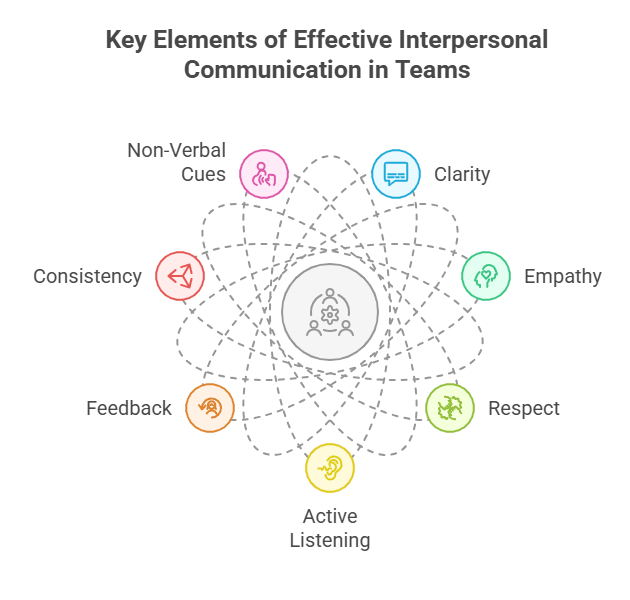
- Clarity: Messages must be straightforward and easy to understand.
- Empathy: Understanding others’ perspectives builds trust and rapport.
- Respect: Valuing diverse views encourages inclusive dialogue.
- Active Listening: Engaging with what others say fosters mutual respect.
- Feedback: Regular input helps guide and refine team behavior.
- Consistency: Uniform messages prevent confusion.
- Non-Verbal Cues: Body language, eye contact, and tone often communicate more than words.
Focusing on these elements helps teams maintain productive and respectful interactions.
The Future of Interpersonal Skills in a Digital-First World
As remote and hybrid work environments become more common, the nature of interpersonal skills and communication is evolving.

- Virtual Empathy: Adapting emotional intelligence to digital formats.
- Digital Body Language: Interpreting tone, timing, and phrasing in online messages.
- AI in Communication: Use of tools like chatbots to assist but not replace human connection.
- Global Teamwork: Increased need for cross-cultural communication skills.
- Mental Health Awareness: Emphasizing psychological safety and well-being in remote setups.
- Continuous Learning: Encouraging ongoing training in communication and empathy.
Future teams will need to consciously develop interpersonal skills suited to digital and global workspaces.
For More Content Check Out :- BMB 101
Conclusion
Interpersonal skills and communication are fundamental to the success of teams in any business context. Their influence spans productivity, innovation, morale, and organizational culture. While challenges persist—especially in today’s digitally connected but emotionally distant world—teams that prioritize and cultivate effective communication and interpersonal dynamics will consistently outperform those that don’t. For MBA students, mastering these skills is not only critical for their academic group work but also indispensable for their future leadership roles in organizations. Understanding, practicing, and continuously improving these abilities can transform good teams into great ones.

